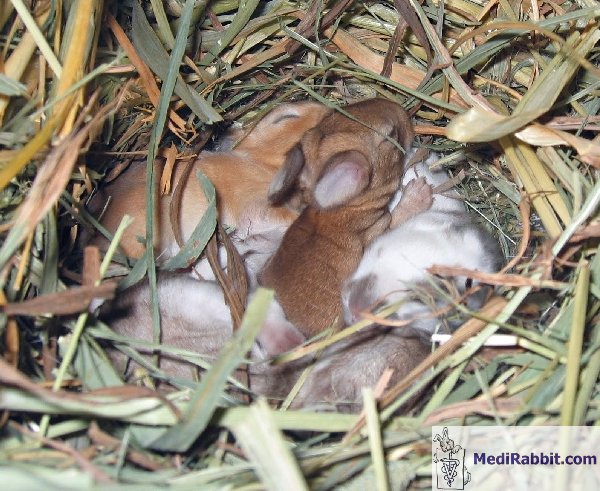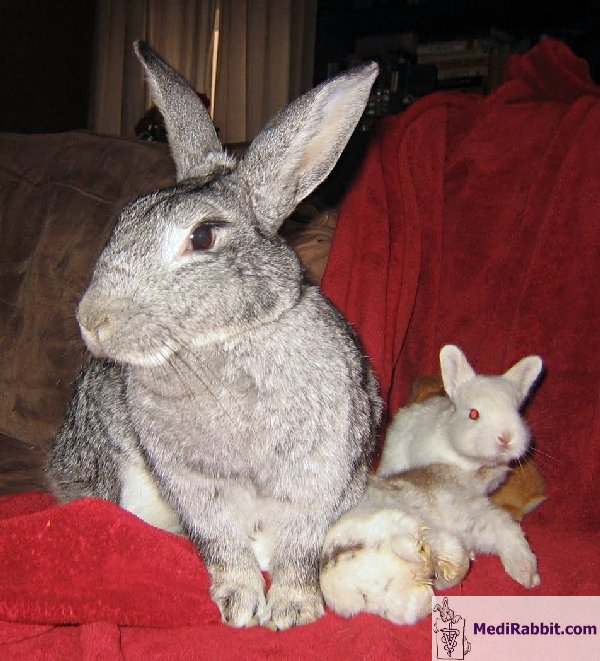Escherichia coli and the
protective role of
Lactobacillus casei in newborn rabbits
Esther van
Praag, Ph.D.
|
MediRabbit.com is
funded solely by the generosity of donors. Every
donation, no matter what the size, is appreciated and will aid in the continuing
research of medical care and health of rabbits. Thank you |
|
Newborn rabbits are unique in the animal
world because their gastrointestinal tract is sterile and free of bacteria
during the first weeks of life (depending on the study, this can vary between
a few days and three weeks). This is notable because the pH of doe's milk
typically ranges from 5 to 6.5, which would allow bacterial survival, growth,
and colonization. Rabbit milk is notable for its high content of C8 and C10
fatty acids, which possess bacteriostatic properties and effectively inhibit
the growth of bacteria in the digestive tract of newborns. These molecules
are sometimes referred to as "milk oil," and their activation
requires two parameters: milk from the mother and stomach from the suckling.
This measure is intended to protect day-old newborns from the growth of
pathogen bacteria, which can lead to fatal outcomes such as necrotizing
enteritis or generalized sepsis. Bacteria that are absorbed during birth and
via breastfeeding will survive the passage through the stomach and intestine.
These bacteria will then accumulate in the cecum, the final section of the
digestive system (colon), and the rectum.
At 10-15 days of age, newborn rabbits
demonstrate increased strength and curiosity, and they typically leave the
nest. They begin to eat solid food (such as hay, fresh vegetables, and
pellets) as well as the hard feces of the doe. Up to six weeks of age, young
rabbits gradually decrease their milk intake. Therefore, as a result: - The
concentration of C8 and C10 fatty acids (milk oil) decreases gradually in the
anterior digestive system; - The pH
level of the stomach declines from approximately 5–6 to 1–2, forming a
barrier that hinders the proliferation of bacteria and eliminates ingested
bacteria; - Microorganisms
that have been ingested and survived in the cecum and lower portion of the
intestine and rectum will begin to multiply. The process of translocation
(spread) of intestinal bacteria from the rectum up to the upper portion of
the small intestine (the duodenum) is possible. When the right bacteria are
present, proper digestion and fermentation of solid food becomes possible.
This process typically takes between a few days and a few weeks. The various stages of bacterial
colonization of the digestive tract are critical, yet they are also delicate.
Indeed, the presence of microorganisms within the gastrointestinal tract is
influenced by factors such as diet, type of forage, and stress levels. The
colonization of sterile portions of the intestine by pathogen bacteria may
lead to organ failure, necrotizing enteritis, diarrhea, and—in severe
cases—fatal enteric trouble or sepsis. Therefore, it is essential to maintain
the rabbits with the mother until they reach eight weeks of age. Separation
should only be considered when necessary. Once a healthy bacterial flora has
colonized the GI tract, the development of pathogen bacteria will be
hindered. It has been hypothesized that the consumption of food fermented by
lactobacilli contributes to maintaining a healthy balance between
lactobacilli species and other microbial flora within the gastrointestinal
tract of animal species that naturally host these bacteria. Orphaned rabbit babies fed on an
alternative source of milk do not receive the protective C8 and C10 fatty
acids, and often show increased sensitivity to enteric infections. One of the
bacteria that cause fatal enteritis is Escherichia coli. A recent
paper (2001, see reference) discusses the protective role of Lactobacillus
casei, a bacterium found in probiotic preparations such as Protexin,
Probiocin, Benebac, or Probios, against a toxin-producing strain of Escherichia
coli. This bacterium has been associated with
several health concerns, including hemorrhagic colitis (inflammation of the
colon, accompanied by heavy bleeding), hemolytic-uremic syndrome (fever,
acute renal failure, dissolution of red blood cells, and low number of
platelet cells), and complications in the central nervous system. The mucosal
damage in the GI tract is severe, though not uniform. It correlates with the
number of observed pathogenic bacteria and the concentration of the toxin.
The damage is more pronounced in the cecum and colon, and less so in the
small intestine. The study indicated that the majority of
infected rabbits exhibited diarrhea promptly. Newborn rabbits treated with Lactobacillus
casei developed diarrhea as well, but symptoms were less severe (16%
severe diarrhea against 77.3% in the control group). The growth of the
bacteria showed no difference between the two groups up to day 4 after
infection; however, at day 7, the number of viable bacteria was 100-fold
lower in the Lactobacillus casei-treated group. The same is observed
for the toxin concentration. It remained stable after day 4 in rabbits
treated with Lactobacillus casei. Histopathologic examination of cecum,
intestine, and colon showed that the control group suffered severe damage: Small
intestine: - necrosis, - vacuolation of epithelial cells. Cecum: -
exfoliation of epithelial cells - pseudo-eosinophil (type of white blood
cell) infiltration, - mitotic activity. Colon: - exfoliation of epithelial cells necrosis None of the above pathology has been
observed in Lactobacillus casei treated rabbits. The pH levels in the stomach and
intestines of newborn rabbits were found to be high at 5.1 and 6.5,
respectively, with no observed differences between the two groups. It is
likely that the high pH aid the Lactobacillus casei bacterium in
surviving the gastric passage and enabling its colonization of the colon,
cecum, and large intestine of young rabbits. The concentration of lactic acid
was slightly higher in Lactobacillus casei-treated rabbits than in the
control group. Volatile fatty acids, such as lactic
acid, are known for their potent bactericidal properties. These acids are
often added to the diet or water of weaning animals to reduce the development
of pathogenic bacteria. Lactic acid has been shown to impact cell
membranes, altering the rate of exchange of H+ and Na+ ions, the activity of
the plasma membrane H+/ATPase activities, and the fatty acid composition of
the membrane. This process leads to the acidification of the cytoplasm. In
the case of this Escherichia coli strain, it was demonstrated that a
concentration of 3.2 mM lactic acid was required to inhibit its development,
while less than 1 mM was found in vivo. Therefore, the presence of lactic
acid may not account for the observed differences between the control and Lactobacillus
casei-treated groups. Lactobacilli and Bifidobacilli have also been shown to
increase the secretion of IgA, or immunoglobulin A, which is an antibody that
deactivates the activity of foreign bodies. This was also observed in the
newborn rabbits. Higher levels of toxins in a specific organ (e.g., the
colon) have been found to be associated with higher levels of mucosal IgA. The study's findings suggest that the
preventive administration of Lactobacillus casei in newborn rabbits
can protect them from Escherichia coli enteritis by enhancing the
secretion of specific IgA. In this case, the protective effect of lactic acid
is uncertain. The in vitro bactericidal effect required concentrations that
were three times higher.
Acknowledgements
I
would like to express my gratitude to Linda Bayley (USA) and the rescued doe,
as well as to Karen Comish (Israel) and Pepe for caring feeding her newborn rabbit
so well. Further information
Anderson LC, Rush HG, Glorioso JC.
Strain differences in the susceptibility and resistance of Pasteurella
multocida to phagocytosis and killing by rabbit polymorphonuclear
neutrophils. Am J Vet Res. 1984; 45(6):1193-8. Dinsmore JE, Jackson RJ, Smith SD. The
protective role of gastric acidity in neonatal bacterial translocation. J
Pediatr Surg. 1997;32(7):1014-6. Glass RL, Troolin HA, Jenness R.
Comparative biochemical studies of milks. IV. Constituent fatty acids of milk
fats. Comp Biochem Physiol. 1967; 22(2):415-25. Harcourt-Brown F. Textbook of Rabbit
Medicine. Butterworth Heinemann, Oxford, 2002, p 55-56. Ogawa M, Shimizu K, Nomoto K,
Takahashi M, Watanuki M, Tanaka R, Tanaka T, Hamabata T, Yamasaki S, Takeda
Y. Protective effect of Lactobacillus casei strain Shirota on Shiga
toxin-producing Escherichia coli O157:H7 infection in infant rabbits.
Infect Immun. 2001; 69(2):1101-8. Schley P. Rabbit milk - composition
and withdrawal of samples, Berl Munch Tierarztl Wochenschr. 1975;
88(9):171-3. Van Camp JM, Drongowski R, Gorman R,
Altabba M, Hirschl RB, Coran AG. Colonization of intestinal bacteria in the
normal neonate: comparison between mouth and rectal swabs and small and large
bowel specimens. J Pediatr Surg. 1994;29(10):1348-51. |
|||||||
e-mail: info@medirabbit.com








